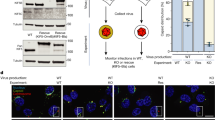Abstract
IN both experimentally infected animals1,2 and in asymptomatic human subjects3,4 herpes simplex virus (HSV) can establish a latent infection in the sensory ganglia of the nervous system. It is probably the periodic reactivation of virus within these ganglia that gives rise to recurrent herpetic eruptions on epithelial surfaces innervated by the infected ganglia. The ganglia of the peripheral autonomic nervous system seem to share a common embryogenesis with sensory ganglia5. Although it has been shown that acute infection of autonomic ganglia with HSV6 and the related herpesvirus, pseudorabies virus7–9, can occur, it has not been established that the peripheral autonomic nervous system (ANS) can support a latent infection with these or other viruses. We report here a marine model of latent infection of the superior cervical ganglion (SCG) of the sympathetic division of the ANS.
This is a preview of subscription content, access via your institution
Access options
Subscribe to this journal
Receive 51 print issues and online access
$199.00 per year
only $3.90 per issue
Buy this article
- Purchase on Springer Link
- Instant access to full article PDF
Prices may be subject to local taxes which are calculated during checkout
Similar content being viewed by others
References
Stevens, J. G., and Cook, M. L., Science, 173, 843–845 (1971).
Walz, M. A., Price, R. W., and Notkins, A. L., Science, 184, 1185–1187 (1974).
Baringer, J. R., and Swoveland, P., New Engl. J. Med., 288, 648–650 (1973).
Bastian, F. O., Rabson, A. S., Yee, C. L., and Tralka, T. S., Science, 178, 306–307 (1972).
Weston, J. A., Adv. Morphogenesis, 8, 41–114 (1970).
Dillard, S. H., Cheatham, W. J., and Moses, H. L., Lab. Invest., 26, 391–402 (1972).
Sabin, A., Proc. Soc. exp. Biol. Med., 38, 270–275 (1938).
Dempsher, J., Larrabee, M. G., Bang, F. B., and Bodian, D., Am. J. Physiol., 182, 203–216 (1955).
Field, H. J., and Hill, T. J., J. gen. Virol., 23, 145–157 (1974).
Hampar, B., Notkins, A. L., Mage, M., and Keehn, M. A., J. Immun., 100, 586–593 (1968).
Jacobowitz, D. M., in The Peripheral Nervous System (edit. by Hubbard, J. I.), 87–110 (Plenum, New York and London, 1974).
Cook, M. L., and Stevens, J. G., Infect. Immun., 7, 272–288 (1973).
Price, R. W., Walz, M. A., Wohlenberg, C., and Notkins, A. L., Science, 188, 938–940 (1975).
Author information
Authors and Affiliations
Rights and permissions
About this article
Cite this article
PRICE, R., KATZ, B. & NOTKINS, A. Latent infection of the peripheral ANS with herpes simplex virus. Nature 257, 686–688 (1975). https://doi.org/10.1038/257686a0
Received:
Accepted:
Issue Date:
DOI: https://doi.org/10.1038/257686a0
This article is cited by
-
Immunisation against HSV-1 keratitis with a synthetic gD peptide
Eye (1995)
-
Gastrointestinal invasion by herpes simplex virus type 1 inoculated cutaneously into the immunosuppressed mice
Archives of Virology (1994)
-
Molecular biology of herpes simplex virus type 1 latency in the nervous system
Molecular Neurobiology (1993)
-
Targets of herpes simplex virus type 1 infection in a mouse corneal model
Acta Neuropathologica (1991)
-
Reactivation of latent Herpes simplex virus-1 (HSV) from mouse footpad cells demonstrated by in situ hybridization
Archives of Virology (1989)
Comments
By submitting a comment you agree to abide by our Terms and Community Guidelines. If you find something abusive or that does not comply with our terms or guidelines please flag it as inappropriate.



